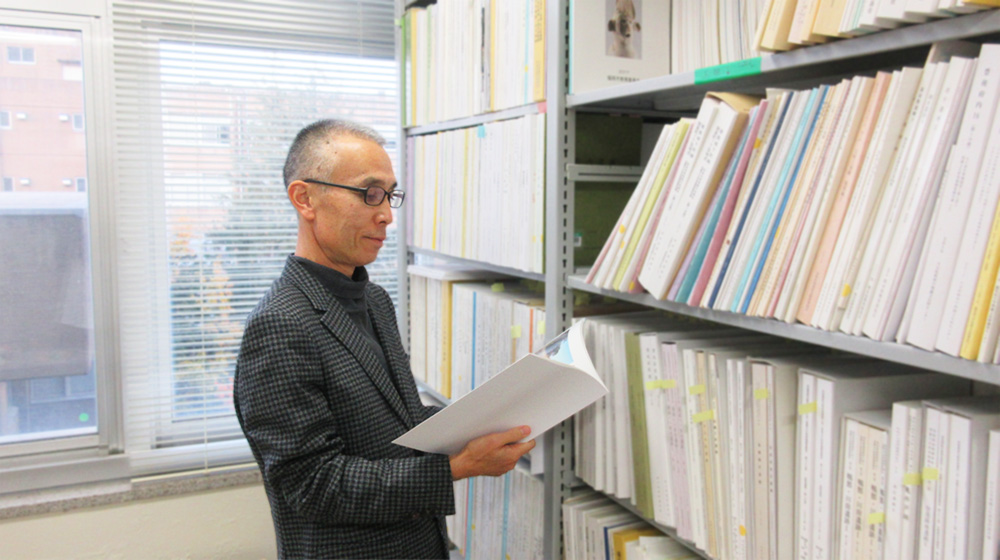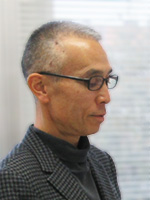[Interview] From an encounter with archaeology up to present – SHIRAISHI Noriyuki

Prof. SHIRAISHI Noriyuki engages in the study of Mongolian archaeology. We had an interview with him to find out what made him interested in archaeology and what led him to the world of archaeology. We also asked the questions of what brought him to Niigata University and how COVID-19 has affected his research.
Fragments of earthenware found in a field opened the door to the world of archaeology
――When were you first attracted to archaeology and why?
Shiraishi When I was a fourth-grade elementary school student, I happened to hear that fragments of Jomon earthenware had been unearthed in a field owned by the grandmother of a friend of mine. I went there and found some broken pieces of patterned potteries and obsidians myself. It was fun. From then on, I started visiting remains every holiday by looking up the locations. I fell for archaeology while I was unaware.
――Is that when you started to wish to study archaeology?
Shiraishi Yes, I think so. It looks like I was telling people around myself that my dream was to become an archaeologist. Since scientific knowledge is required for archaeology, when I was in senior high school, I worked hard on mathematics, geology, and biology. I find what I have learned from these subjects practically useful for my research.
When I was a second-year senior high-school student, I was lucky to find remains of the Paleolithic era, and it became a hot topic. I was pleased that researchers had an interest in the remains, which made me decide that I would pursue my Paleolithic studies in college. When I was wondering which university was best for me, I came across a paper on the Siberian Paleolithic written by KATO Shimpei, then a professor at the University of Tsukuba. I was intrigued to learn from the paper that there was such a field of study and wondered what kind of research was carried out there. I decided to advance to the University of Tsukuba without question. I learned a lot from Prof. Kato, who took me on a number of his survey expeditions to Siberia and China. He also was the one that took me to my first visit to Mongolia.
Mongolia was the trigger for relocation to Niigata
――What made you become a university faculty member? Were there other options that you considered?
Shiraishi I always wanted to be a researcher. I had options other than university. I considered working at a museum or joining an excavation team of a governmental research organization, and therefore gained a teacher’s certificate and a curator’s qualification. It was after I advanced to a doctoral course that I decided to continue my studies at university.
――What brought you to Niigata University?
Shiraishi I came to Niigata in 1994 to take up a new post. Back in those days in Niigata, Japanese public and private sectors jointly floated “Rim-Japan Sea Area Initiative.” It was a Niigata-led initiative involving South Korea, coastal states of Russia, and the north-eastern part of China to boost mutual economic and cultural ties among them. When Niigata University, a member of the initiative, decided to hire researchers specializing in these regions, they contacted me. I was lucky; they thought that Mongolian archaeology was unique and interesting.
Spending summer in Niigata for the first time in 20 years
――What do you do for fun besides research? What are you into?
Shiraishi I enjoy running. I run about 10 kilometers almost every other day. I also participate in marathon races quite often. Otherwise, I am at a desk writing papers and books.
――You go to Mongolia every year. What do you think is most different between Mongolia and Japan in terms of lifestyle?
Shiraishi The most different is diet. Meat is the staple food in Mongolia. They eat more than 300 grams of meat, which is mostly mutton, a day. While Japanese prefer lean meat, Mongolians prefer fatty meat. For this reason, their diet is generally heavy and stodgy. I did not like the taste at first, but I am now used to it. I’d rather say I miss fatty meals in Mongolia. Even while I’m in Japan, I tend to prefer fatty meat. I run whenever I have time perhaps because I know I am taking in too much fat.
――You could not visit Mongolia this year due to the spread of COVID-19. Do you find anything different from other years?
Shiraishi I usually stay in Mongolia for a couple of months a year, which are the summer months in most cases. This year, I spent summer in Niigata for the first time in 20 years, which I thought was a somewhat refreshing experience.
Archaeological work involves not only excavation but equally importantly filing work like drawing pictures of excavated artifacts and writing papers. Every time I return from overseas, I immediately get bogged down with lectures and administrative work. As a result, there were more than ten years of documents waiting to be filed. This year I could afford time to sort out all the documents, which I think was profitable and meaningful in a sense.
Profile
Interview date: November 16, 2020
Interview/text: MIYAJIMA Ryushi (Undergraduate student, Faculty of Humanities)
Related Link:
Mongolian Archaeology

 SHIRAISHI Noriyuki
SHIRAISHI Noriyuki